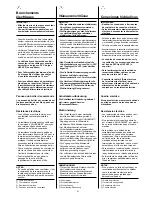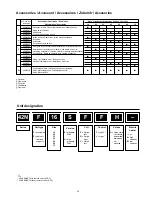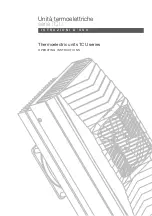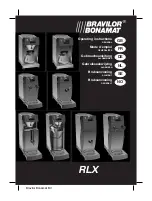
16
Front view /
Vista frontale / Vue de front / Vorderansicht / Alzado
Space for water connections /
Spazi per allacciamenti idraulici
/ Espace nécessaire pour les
branchements d’eau /
Platz für Wasseranschlüsse
/ Espacio para conexiones hidráulicas
1
IN
2
OUT
3
Cool Ø 3/4” gas female
4
Heat Ø 1/2” gas female
E
Condensate drain
F
Auxiliary drain pan
(accessory)
7
Floor
Water connections
1
INGRESSO
2
USCITA
3
Freddo Ø 3/4” Gas femmina
4
Caldo Ø 1/2” Gas femmina
E
Scarico condensa
F
Bacinella ausiliaria
(accessorio)
7
Pavimento
1
ENTRÉE
2
SORTIE
3
Froid Ø 3/4” gaz femelle
4
Chauffage Ø 1/2” gaz femelle
E
Bac à condensats
F
Bac à condensats auxiliaire
(accessoire)
7
Sol
1
EIN
2
AUS
3
Kühlung Ø 3/4” -
Anschluss mit Innengewinde
4
Heizung Ø 1/2” -
Anschluss mit Innengewinde
E
Kondensatablauf
F
Hilfs-Ablaufwanne (Zubehör)
7
Fußboden
1
Entrada IN
2
Salida OUT
3
Frío hembra Ø 3/4” gas
4
Calor hembra Ø 1/2” gas
E
Recogida de condensado
F
Bandeja auxiliar de recogida de condensado
(accesorio)
7
Suelo
Le tubazioni dell’impianto idrico potranno
arrivare sia da pavimento che da parete
utilizzando gli spazi secondo la figura.
La batteria sull’unità viene fornita con i
collegamenti idraulici posizionati come da
richiesta in fase d’ordine.
E’ comunque possibile invertire in cantiere la
posizione degli attacchi nel seguente modo:
• rimuovere il quadro elettrico;
• svitare le 6 viti autofilettanti e rimuovere
la bacinella anteriore;
• s
vitare le 2 viti di fissaggio della batteria
alla struttura, necessarie per il
collegamento della messa a terra della
batteria;
• sfilare la batteria sganciandola per mezzo
delle linguette in gomma e ruotarla
orizzontalmente di 180°;
• posizionare la batteria nella sua nuova
sede agganciandola con le apposite
linguette in gomma;
• rimontare la bacinella anteriore con le 6
viti autofilettanti;
• riavvitare le 2 viti di fissaggio della batteria
alla struttura, necessarie per il collegamento
della messa a terra della batteria;
• posizionare il quadro elettrico sul lato
opposto agli attacchi della batteria
,
tenendo conto che dovrà essere richiesto
come ricambio la piastra speculare a
quella esistente;
• posizionare il sensore di temperatura
nella apposita sede sigillando con stucco
nelle versioni tangenziali;
• inserire il comando nelle apposite
linguette bloccandolo con la staffetta a
corredo.
NOTA:
Rivestire i tubi dei collegamenti con del
materiale anticondensa tipo polietilene o
moltoprene espanso di spessore 5-10 mm.
Collegamenti idraulici
Water piping can enter either from the floor
or from the wall. Leave the space shown in
the figure.
The unit coil can be supplied with water
connections positioned as requested.
However field conversion of the
connections is achieved quite simply as
follows:
• Remove the control box panel;
• Unscrew the 6 self-threading screws and
remove the front drain pan;
• Unscrew the two screws holding the heat
exchanger to the structure, necessary for
earthing the coil;
• Remove the coil by unhooking it with the
rubber tabs and turn it horizontally
through 180°.
• Place the coil into its new position by
hooking it using the special rubber tabs;
• Refit the front drain pan with the 6 self-
threading screws;
• Retighten the two screws holding the
heat exchanger to the structure,
necessary for earthing the coil.
• Position the control box panel opposite
the coil connections
,
consider that you
shall order the plate opposite the existing
plate as a spare part.
• Pass the sensor through the special hole
and seal with sealing material in the
tangential fan versions.
• Position the control into the tabs
provided, blocking it with the supplied
metal plate.
NOTE:
The connection pipes must be insulated
with a condensation-proof material such as
polyurethane, propylene or neoprene of 5
to 10 mm thickness.
196 mm
302 mm
130 mm
A
B
D
E
C
F
D
C
Ø 20 mm
Ø 20 mm
7













































